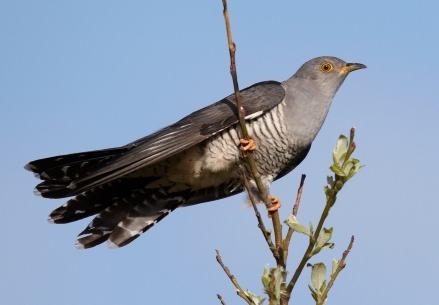 Cuckoo - Cuculus canorus
Cuckoo - Cuculus canorusFamily - Cuculidae
Also known as - Gowk
 Cuckoo - Cuculus canorus
Cuckoo - Cuculus canorus
Family - Cuculidae
Also known as - Gowk

Photo ©2005 Bogbumper
Click photo for a larger image
Common and widespread throughout the British Isles and mainland Europe to Scandinavia, the Mediterranean, Middle East and North Africa where it is confined to the North–West. A migratory bird, leaving Europe in late July and early September to winter in tropical Africa, returning during April and May. Found in a wide variety of habitats, in scrub and open woodland, forest edges and clearings, farmland, grassland, reed beds, marshes and moorland. Several subspecies occur differing slightly in size with small plumage differences. C. bangsi in the Iberian region and North–West Africa where females have a distinctly rufous breast and R. subtelephonus in Middle East.
Both sexes growing to about 33cm (13in), Adult males are generally grey above including the throat and breast, while the underside is white with close black bars similar to a Sparrowhawk. It has short legs and a non–hooked bill and a long graduated tail is black with white spots and very pointed wings which often droop when perched. The adult females are occasionally brown above and white below, and are barred black. Juvenile cuckoos are brown, barred, and have a white patch on the back of the neck.
The cuckoo has a well known call which differs between the sexes and is more often heard than seen. The males have an unmistakable "cook–coo" call, while the females have a babbling call. Feeding mainly on insects and their larvae, Large White butterfly caterpillars are a favourite, notably on Gooseberry bushes. Hairy caterpillars, rejected by most birds, are taken by the Cuckoo who are not poisoned by the caterpillar because the cuckoo bites one end off the caterpillar, slicing it up using its beak and then shaking the insect until the toxic contents are removed.
A brood parasite, the female Cuckoo lays one egg in the nest of another species mainly Reed Warbler, dunnock and Meadow Pipit. The eggs closely resemble the eggs of the host species and are either spotted or solid in colour, depending upon the colour of the host species. The Cuckoo egg is incubated for about 13 days and usually hatches before the host's eggs, the young cuckoo then ejects the other eggs or young so that it will receive all the food brought by the "foster parents". The young cuckoo brooded by the host for a further 20–25 days, usually growing much larger than the hosts. Cuckoos mostly live solitary lives, except during the breeding season when they also become noisier.
 The Cuckoo is listed in the UK Biodiversity Action Plan priority species list.
The Cuckoo is listed in the UK Biodiversity Action Plan priority species list.
Site design ©1999– Brickfields Country Park - Privacy -